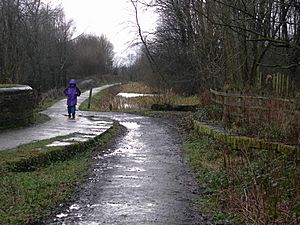Fairbottom Branch Canal facts for kids
The Fairbottom Branch Canal was a small canal in Greater Manchester, England. It was built to help carry coal from mines to factories. This canal played an important part in the local industry a long time ago.
Contents
Where Was It?
The Fairbottom Branch Canal started from the Hollinwood Branch Canal. This was just above lock 22. The canal was about 1.8 kilometers (just over a mile) long. It did not have any locks, which are like water elevators for boats. The canal ended at Fenny Fields Bridge in Bardsley. This area is in the Medlock Valley. It is located between the towns of Ashton-under-Lyne and Oldham.
Canal History
A Canal for Coal
Even though this canal went through mostly countryside, its main job was to move coal. There was a special place to load coal onto boats. There was also a short private canal branch just for coal. A mill was also located along the canal.
The Park Bridge Community
Near the end of the canal, a factory town called Park Bridge grew up. This community was started in 1783 by Samuel Lees. He built a factory to make rollers for machines that made cloth. As more textile machines were needed, the community quickly grew.
After Samuel Lees passed away in 1804, his wife, Hannah Lees, successfully ran the factory. Later, the company was even renamed Hannah Lees & Sons to honor her. The last part of this factory closed in 1963. This was because the textile industry was not as busy anymore.
Around 1800, a special machine called Fairbottom Bobs helped supply water to the canal. This was a Newcomen engine. It worked to pump water out of mines.
The Tramway and "The Ashtonian"
A special track, called a tramway, connected the factory town to the canal. This tramway even had a small tunnel, about 150 meters (150 yards) long. At first, horses pulled the wagons on this track.
In the early 1840s, a steam train named ‘The Ashtonian’ replaced the horses. This train was quite unique! Because the tunnel was so narrow, the driver had to be short. They even had to kneel down to fit through the tunnel. The train's chimney also had to be taken off. This tramway kept working until the 1880s.
Why the Canal Closed
In the early 1930s, the canal had two leaks. This meant the water level had to be lowered. Also, the ground started to sink because of mining nearby. These problems led to the canal closing unofficially in 1932. By 1948, boats could no longer use the canal at all. However, it still had water in it.
Today, much of the old canal path is still there. There are now plans to open parts of it again. This would be for people to enjoy, along with much of the Hollinwood Branch Canal.


